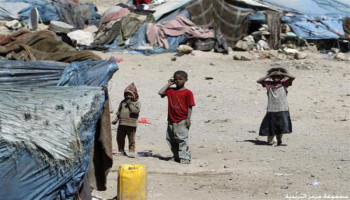The economy of Yemen has recorded a rapid deterioration, since the Saudi-led aggression waged war on the country in late March 2015, which negatively affected the lives of citizens.
But the economic war on Yemen has taken on a more fierce form, since September 2016 when the pro-aggression government, Hadi’s government, issued a decree to reconstitute the Board of Directors of the Central Bank of Yemen and transfer it to the city of Aden, which has caused confusion in the economy. Cutting salaries from employees is one of the most hideous faces of the coalition’s forces by transferring the Central Bank and printing more than two trillion riyals without cover.
After completing the transfer of the Central Bank to Aden, a decision was issued to float the Yemeni riyal against the dollar in 2017 and obliged the banks to deal on the basis of the prevailing exchange rate in the market for the dollar and other foreign currencies according to the bulletin of the exchange rates issued by the Central Bank from its headquarters in Aden, based on the basis of price management officially approved disbursement on a floating basis.
The Central Bank of Aden’s decision to float the riyal has caused the latest continuous jumps for the dollar and foreign currencies against the Yemeni riyal, which contributed to increasing inflation rates and exacerbating poverty levels. The economic suffering was doubled after that by printing more than two (trillion) Yemeni riyals by the Hadi government without cash cover, causing a significant decline in the exchange rate of the riyal against foreign currencies, day after day.
Economic experts and analysts confirmed that the actions taken by the pro-aggression government caused inflation that led to the devaluation of the national currency to devastating levels on the national economy in general, in addition to the ongoing blockade by the coalition on all ports, the prevention of the export of Yemeni goods to abroad and the disruption of the movement of remittances to Yemen by expatriates, which reflected negatively on the citizen's purchasing power, and the rise in prices to crazy levels.
Political analysts say that the deterioration experienced by the Yemeni economy comes as a result of direct targeting by the coalition, stressing that the US ambassador Matthew Tueller threatened the Sana’a delegation during the Kuwaiti consultations in 2016 to take economic measures that would make the Yemeni riyal not equal to the ink on which it was written.
The deterioration of the riyal against foreign currencies was upward. At the beginning of the war, the dollar swung between 215 and 220 riyals then jumped to 370, due to the flotation decision taken by the Central Bank in Aden, reaching today to 730 riyals in the governorates that are under coalition control, while the exchange rate in Sana’a is 610 riyals. The difference is because the Sana’a government has taken measures, including preventing the circulation of the new printed currency.
The continuation of the war and the siege will end in a humanitarian catastrophe, before it is economic, the victim of which is the Yemeni people if the war does not put an end to it.







